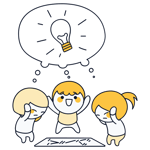Best Software for Agile Project Management 2025: 11 Tools Reviewed
Many organizations today pay lip service to agility. After all, being agile is the opposite of being slow and inflexible - and no one wants that. But if you really want to be agile, you need to put agile project management principles into practice. The right software can help with this.
We'll show you what agile project management software should do and which programs impressed us.
What Is Agile Project Management?
Agile project management is a collection of project control methods that focus on flexibility, ongoing improvement, and quick responses to changes. This contrasts with traditional, plan-driven methods, which often involve rigid structures and lengthy project phases.
Agile project management is iterative and incremental. Instead of having one big project plan that covers everything from start to finish, the project is broken down into smaller parts that teams work on in repeated cycles (iterations or sprints). Learn more about agile principles here:
What Is Agile Project Management Software?
Agile project management starts as just an idea. Teams put it into practice using specific methods that turn these ideals into workable processes. These include frameworks like Scrum or Kanban, which offer various tools and techniques that help teams make their (project) work more agile. The right software can help implement these methods.
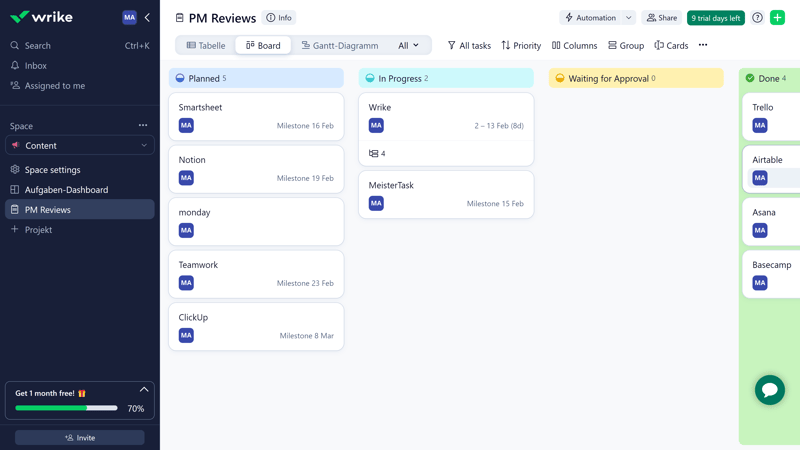
Almost all project management tools offer a Kanban view for projects.
Agile project management software consists of programs specifically designed to support agile principles and practices in project planning and daily work.
They offer a range of features that help teams plan, execute, and monitor their projects using agile methods like Scrum or Kanban.
What Features Are Important in Agile Project Management Software?
Different tools have different focus areas, but all programs should cover some basic features:
Task and Project Management
The key is being able to create tasks in a user-friendly digital interface, assign them to team members, and track their status. This helps you keep track of project progress, tasks, deadlines, and dependencies.Sprint Planning
Tools for planning and managing sprints or iterations help teams set timeframes, goals, and priorities for different project phases.Multiple Views
Kanban boards are just one of many views. Project management software should give you many options to display your projects and tasks - like Kanban boards, tables, lists, calendars, Gantt charts, timelines, and more.Custom Fields
Flexibility is important in task management. You should be able to customize task parameters freely - using both standard fields and custom fields.Collaboration Tools
Agility is a team effort. Project management software should support teamwork with the right collaboration tools. Most importantly, you need to be able to manage team members and their permissions, assign tasks to each other, and communicate (e.g., through comments).Reporting and Analytics
Reporting tools not only provide important insights into project progress but also help optimize team performance and identify areas for improvement.
These are just the basic tools that almost all project management programs should offer. Most tools have many more features and/or different focus areas.
Best Agile Project Management Software
We tested eleven project management platforms, almost all of which support agile methods. We focused on all-round project management tools that weren't primarily or exclusively developed for agile frameworks but can be easily adapted to them.
Here's a quick look at our favorites:
monday.com: The EXPERTE.com Winner for Agile Project Management

Our top pick monday.com* is a flexible platform for project and task management that helps organizations of all sizes and industries plan and organize their work. monday.com earned first place in our comparison thanks to its great mix of ease of use and flexibility.
What Do We Like About monday.com?
monday.com stands out with its modern interface that gives all team members a central view of their tasks and offers great flexibility in customizing workflows. Since it supports most important views and task settings, monday.com works well with different methods and work processes.
It also comes with a wide range of apps and integrations that let you smoothly connect monday.com with your other software tools, plus a powerful automation engine.
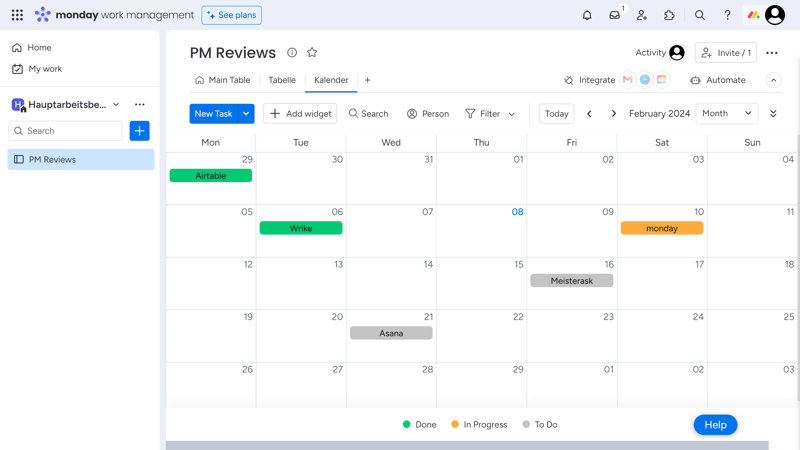
monday.com is EXPERTE.com's overall winner.
Why Is monday.com Good for Agile Project Management?
monday.com includes all the basic tools you need for agile work and managing projects together. The most important features include:
Customizable workflows
Teams can design their work processes to quickly adapt to changes.8 views
monday.com supports project work with flexible workflows and different views like Kanban boards, Gantt charts, and other specialized views.Ready-to-use templates
monday.com offers many templates for agile workflows and processes, like sprint planning or user stories.200+ integrations and apps
monday.com offers more than 200 integrations to expand its built-in features and connect the platform with your other software tools.
What Are Potential Drawbacks of monday.com?
monday.com lacks non-task-related communication tools - for example, (group) chats or private messages. Also, monday.com only offers some standard features in higher-priced plans, including important views like calendar or Gantt charts.
In general, monday.com is also less process-oriented than other project management tools, like Asana. The way it displays processes and task sequences is less dynamic compared to some competitors.
ClickUp: The Versatile All-in-One Solution

ClickUp* is a complete productivity platform that launched in 2017 and now has over 8 million users. The self-proclaimed "One app to replace them all" aims to offer all productivity features in one place to meet almost any use case.
What We Like About ClickUp
ClickUp stands out with its huge flexibility and range of features, letting you customize almost every function, view, and setting. This means ClickUp really can adapt to different needs and work styles as promised - you rarely feel stuck with rigid processes.
Another plus: ClickUp offers what we think is the best free plan among project management platforms. It includes all basic views and has no task or member limits.
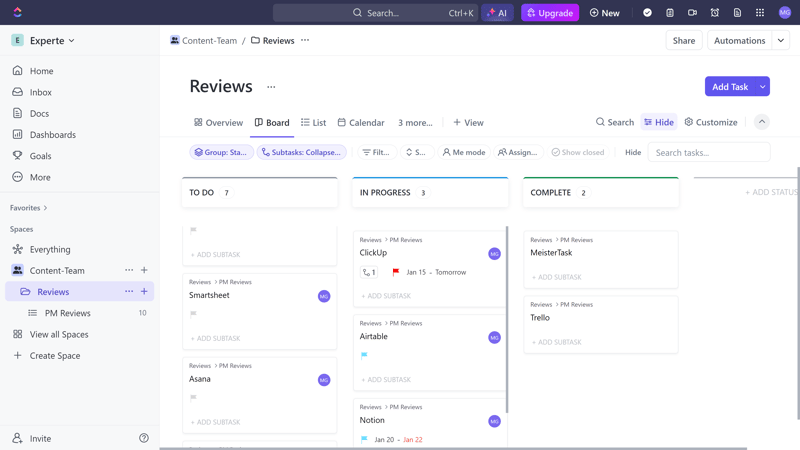
Caption
Why Is ClickUp Good for Agile Project Management?
ClickUp's flexibility supports many different work styles, including agile methods. Key features include:
10 Views
Among the tools in our review, ClickUp offers the most views, including Kanban, Calendar, Mind Map, Gantt, and Map.Agile Templates
You don't need to build your agile dashboards from scratch - you can use ready-made templates for simple sprints or bug queues.Real-time Collaboration
ClickUp goes beyond comments and assignments by offering real-time teamwork through group chats, whiteboards, and shared document editing.Many Integrations
ClickUp can be expanded with many apps and integrations.
What Are ClickUp's Weaknesses?
ClickUp's flexibility comes at a cost: It takes longer to get started, has a steeper learning curve, and might need more work to adapt to your company's processes compared to simpler tools.
Also, ClickUp's interface isn't as fast as its competitors' dynamic dashboards. It can get a bit sluggish at times.
Asana: Fast and Agile for Process-Driven Work

Asana* is a project management platform from the US, created by former Facebook employees. The software aims to boost team productivity by cutting down on work about work.
What Do We Like About Asana?
Asana's interface is top-notch: It's clean and fast, makes it easy to find all important features, and adds excitement to what could be "boring" task management.
Asana also offers versatile views and task features, plus detailed reports that make project data easy to understand. We also really like the automation options, with Asana's workflows and rules being particularly user-friendly and clear.
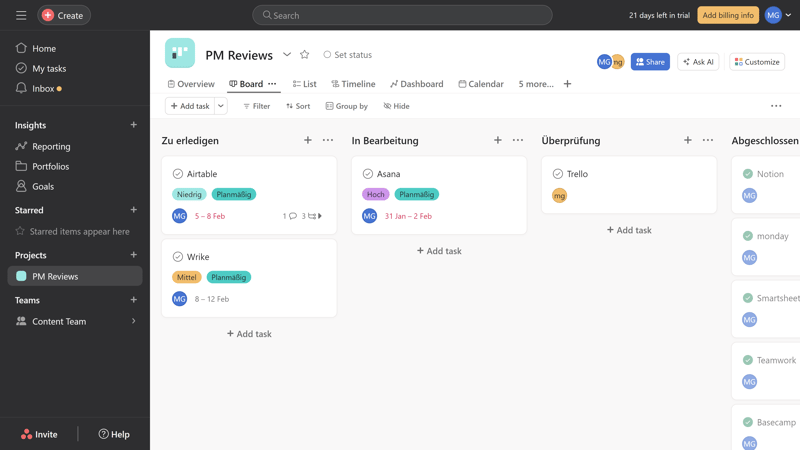
The Asana interface is quick and dynamic.
Why Is Asana Good for Agile Project Management?
Asana easily adapts to agile frameworks and includes many features that support Scrum, Kanban, and other methods:
8 Views
With list, board, timeline, and other views, Asana offers different ways to organize and display projects and tasks.Versatile Reports
The ability to show project data through ready-made and custom real-time charts in dashboards gives you valuable insights into project status and team performance.Extensive Automation
With Asana's powerful workflows and rules, you can automate routine tasks. This not only saves time but also helps teams focus on their core work.Agile Templates
Asana provides several templates, including ones for sprint planning, retrospective, and product backlog.
What Are Potential Drawbacks of Asana?
Asana is less flexible than ClickUp: You can't customize tasks as extensively, partly because there are fewer custom field types. Asana doesn't offer advanced collaboration features like whiteboards or real-time document editing.
Teamwork.com: Integrated Project Management for Agile Client Projects

Teamwork.com* focuses on a specific type of team: those who manage client projects. The platform helps client-facing teams (like agencies) with their daily project work and high-level planning - including improving profitability and allocating resources properly.
What Do We Like About Teamwork.com?
Beyond standard project management features, Teamwork.com stands out from competitors mainly through features that make working with clients easier.
It helps teams complete client projects within budget, schedule team members' work hours smartly, and track time. You can even handle billing through Teamwork.com.
The focus on team collaboration shows in its comprehensive digital teamwork tools. Teamwork.com offers a project-based forum for team discussions, a wiki-style notebook feature, and a review system. It also includes built-in tools for chat, document management, and customer support.
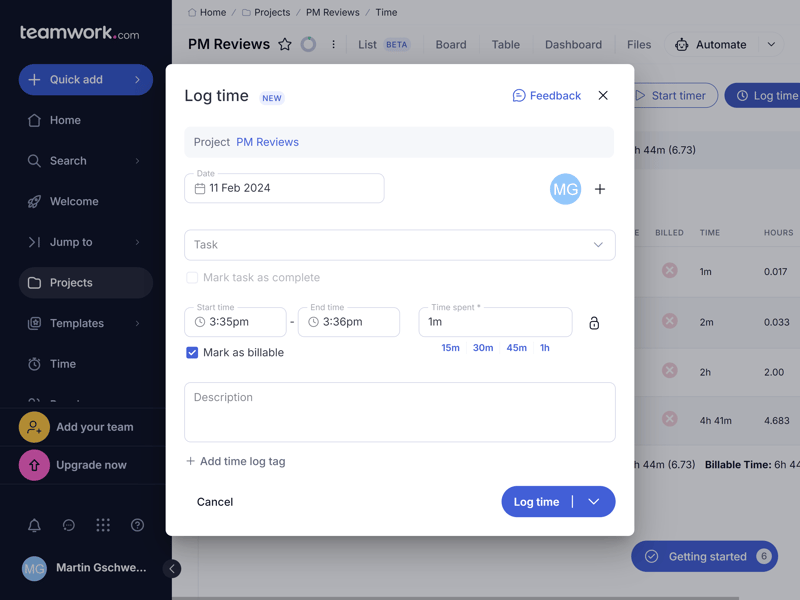
Teamwork.com includes handy budget and time tracking features.
Why Is Teamwork.com Good for Agile Project Management?
Agile project management is popular for client projects - after all, customer satisfaction is a key principle of agile methods. Teamwork.com adapts well to both agile and traditional frameworks, and offers these advantages for agile work:
7 Views
Teamwork.com includes all essential views like table, list, Kanban, milestones, and Gantt charts, making agile planning and tracking of tasks and projects much easier.Many Team Collaboration Tools
You can invite different types of users to your Teamwork.com account and work with them in real-time, both asynchronously and live.Customer Focus
Customer needs are at the heart of agile work. Teamwork.com offers many features to involve clients and their needs in your projects - from inviting them to the dashboard with limited access to helpdesk and feedback options.Budget and Billing Features
Built-in features for budgeting, cost analysis, and billing support agile practices by providing clear project finance insights and helping with data-driven decision making.
What Are Teamwork.com's Weaknesses?
Teamwork.com offers fewer task-level customization options compared to competitors like monday.com or ClickUp. For example, the choice of custom fields is limited, so you'll need to rely more on standard elements.
Due to its wide range of features, Teamwork.com can feel a bit complex and overwhelming - especially if you don't use or need advanced features like time tracking or billing, or if you already use other programs for these tasks.
Notion: Agile Wiki Platform With Project Management Features

Notion* is a versatile organization tool from Notion Labs Inc. It combines project management, document creation, wikis, databases, and collaboration features in one user-friendly cloud platform.
What Do We Like About Notion?
Notion stands out with its flexibility and adaptability. This applies not just to project management, but to information organization in general. Thanks to its wiki-like document structure, Notion works well for many purposes beyond managing projects and processes.
Notion users can customize their workspaces with many building blocks, making it easy to organize projects, tasks, and documents. The wiki features we mentioned help teams manage and share knowledge.
Another advantage of Notion is its great value for money, including a solid free plan.
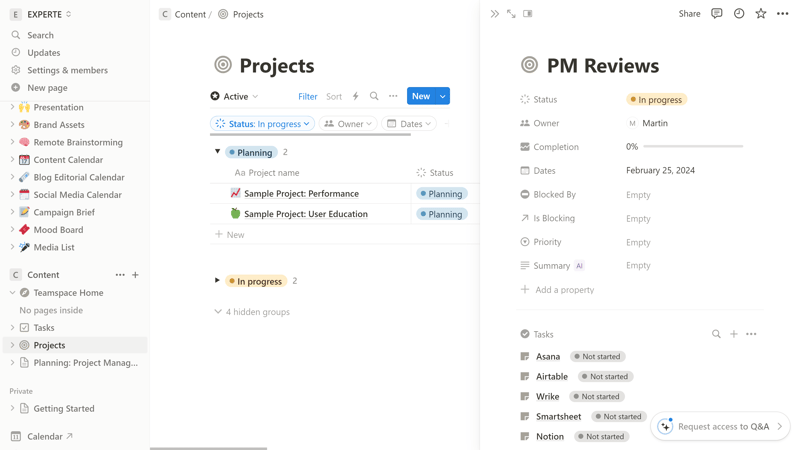
Notion combines wiki, document, and project management features in an affordable package.
Why Is Notion Good for Agile Project Management?
Notion is what you make of it. While it wasn't built specifically for agile project work, it supports almost all key features you need, including:
7 flexible project views
Notion supports all important views, including Kanban boards, lists, timelines, and calendar views.Wikis for documentation and knowledge sharing
Notion lets you create detailed wikis. Agile teams can store and share their documentation, including sprint reviews, retrospectives, and process guidelines in one central place.Agile templates
Notion offers many user-created templates that you can simply fill with your content.
What Are Notion's Weaknesses?
Notion isn't a pure or typical project management tool - it's mainly a wiki platform that you can use for project management. If you're used to process- or project-focused software, you might find Notion lacking in focus or structure.
It also doesn't have real-time communication features like chat or private messages, and it's missing advanced project management features like time tracking or detailed reporting tools.
More Project Management Tools
Our top 5 is just the beginning: We tested eleven project management tools in detail and checked how well they work for agile teams.
Check out our complete ranking with links to detailed reviews here:
Bottom Line
Agile work isn't just about having the right software - it starts with the right mindset. You can only unlock the potential of agile methods if you're ready to apply agile principles and rethink traditional ways of working. Project management tools like monday.com, ClickUp, or Asana help you do just that.
Since project management platforms affect every team member's daily work, it's important to find a tool that works for everyone and adapts to your organization's unique needs. We've thoroughly tested eleven project management platforms to help you make the right choice.
Frequently Asked Questions
Agile project management is a way to run projects that focuses on flexibility, ongoing improvement, and quick responses to changes. It breaks down projects into smaller parts and works on them in repeated cycles.
Agile project management includes methods like Scrum and Kanban that help teams work on projects in cycles and quickly adapt to changes. The main ideas include constant improvement, close teamwork with customers, and breaking projects into smaller, manageable pieces.
Agile tools are software programs designed to support agile project management principles and practices. They include features like task and project management, sprint planning, different project views, custom fields, collaboration tools, and reporting options.





















